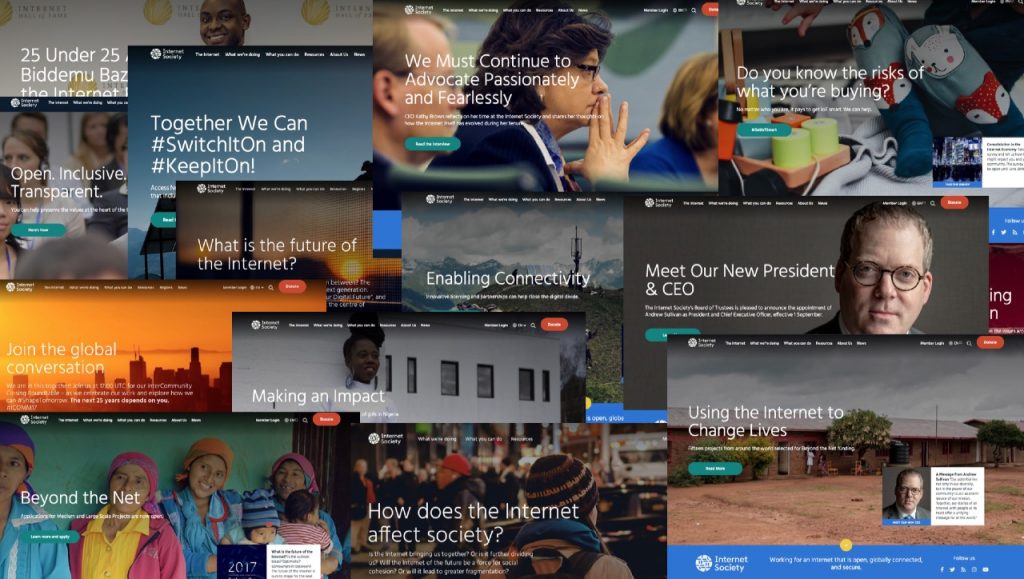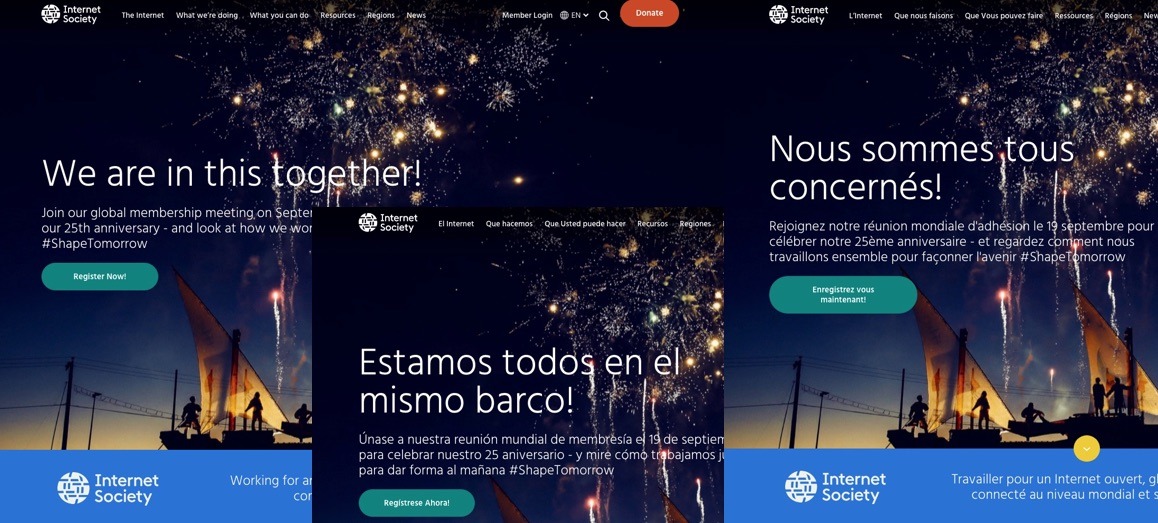As we built our new website, one of my own guiding principles was “POSSE“, a content publishing model from the “IndieWeb” movement. The idea is:
Publish on your
Own
Site,
Syndicate
Elsewhere
Essentially, make sure you own your own content – and then share it out onto other sites and services. (See the IndieWeb page about POSSE for more discussion.) Make your own website the “hub” for all your content, and then have spokes going out to all the other places where people might discover and learn about your content.
To me, this model is the best way to support the principles of the open Internet, while engaging people in the places where they already are.
Why does this matter?
We aren’t just publishing reports, papers, blog posts and articles for the sake of talking about what we are doing.
We are publishing content to bring about change that ensures the Internet remains open, globally connected, and secure. As we said in our vision statement for the new website:
Our website is a driving force in realizing our mission of an open Internet for everyone. It empowers all who care about a free and safe Internet and inspires action to make a positive difference.
Our website exists in support of our mission, of our 2018 Action Plan, and of our campaigns to shape the Internet of tomorrow.
But of course, once we publish content, the challenge is to get people to actually READ (and share) that content.
Sadly, we’ve not yet been able to convince everyone on the Internet to set www.internetsociety.org as their home page! (Have you done that yet? Would you consider it?)
So…. we need to share / syndicate our content out to the places where people may discover that content.
We need to go where people are.
WordPress and RSS feeds
The good news about the POSSE model is that WordPress brings many advantages. For instance, it has strong support of RSS feeds, allowing our content to be easily used by viewers – and also published on other sites. You simply add “/feed/” to the end of any URL for a category, tag, or author and… ta da… a feed of all the stories. Super easy and simple.
Unfortunately, the use of dedicated RSS readers has fallen out of style. So while this is an awesome feature, fewer and fewer people are using it.
Thankfully, WordPress also supports a variety of plugins that help with sharing our content out to other channels.
Reaching new audiences
As we reach out to those other channels, it is critical for us to reach NEW audiences. If we only talk to the technical community out of which we emerged, or if we only speak to the “Internet governance” community in which we are involved, we will not be able to fully create the change we believe needs to happen.
We need to reach far larger audiences and help them discover what we are writing about. We need to reach the people who don’t know what “IoT” is – and help them understand why we need it secure by default. We need to reach people in areas without Internet connectivity – and help them understand how community networks can help. We need to reach people who can influence policy makers – and help their regulators understand how the Internet works, and how decisions around the Internet need to involve all sectors of society.
We need many people to take action.
Our ongoing work with the news media is a key part of reaching new audiences. We have had great success in this, and we will continue to expand our efforts. This is critical to our work.
Similarly, we also reach new audiences through building relationships with other media sites to get our articles published (or re-published/syndicated) on those sites. This can bring our ideas to whole new audiences that have not seen our site or even heard of the Internet Society.
But there has also been a large shift in how people discover news and content. For example, recent reports from the Pew Research Center found that 67% of Americans get at least some of their news from social media. For some groups and demographics, the percentage is even higher. Similar research from Pew showed a median of 35% of people globally getting news daily through social media.
Sharing out to social channels
Given these trends, it is critical for us to get our content out into the social channels where it can be found – and shared. Whenever we publish an article or blog post, we typically share it to at least:
- one or more Twitter accounts
- our Facebook page(s)
- our LinkedIn profile
- our Google+ page
(See our list of social channels.)
If we look a why we use each of these channels:
- Twitter has consistently been an excellent way to reach people across a very wide range of social segments and industries. We also find news media see our content, as do policy makers, ISOC members and more.
- Facebook gives us the potential to reach over 2 billion users (per Facebook’s Q4 2017 monthly average users) around the world. It has the largest reach of any of the currently available platforms.
- LinkedIn has been a way to share out content out to a professional and business-oriented audience.
- Google+ historically was a way to reach some elements of our technical audience, although we’ve seen the level of engagement drop there significantly over the past year or two.
The sharing aspect is a key element. As the Pew Research study showed, people are more likely to trust news and links they see from their friends and family. So enabling people to share our content with others is critical.
Now, we don’t only “broadcast” out our content into our social channels. These channels are also one way we gather feedback and comments from people about our content.
We also do use other ways to engage with people in those channels. For instance, our recent polls on Twitter related to IoT and consumer rights. But the distribution of published content remains a major reason why we use the channels.
Sharing out to other channels
Beyond these social channels, we also syndicate and share our content out to other channels on a case-by-case basis. Some of those include:
- Email lists– We have a wide range of email lists available to Internet Society members. (Membership is free – join today!) Some include Chapter leaders or Organization members. Some are for our Special Interest Groups (SIGs). Others are for open discussion such as the “Internetpolicy” list or the Connect Open Forum. Our challenge here is that with the volume of content we publish, we want to share carefully so we don’t overwhelm people’s inboxes.
- Medium– We sometimes cross-post articles to our Medium account, although increasingly we are developing specific content for the site.
- CircleID– For many of our technical and policy folks, we have found that re-publishing our posts on CircleID (under individual author’s names) has brought the information strong additional visibility
Occasionally, we will also post content to some of the sites that aggregate links and provide news listings such as:
- Hacker News – our developer-focused and very technical articles often do well here.
- Reddit – some of our content fits in well in different sub-reddits.
We also have used our Instagram account for some campaigns, too.
Future channels
We are always watching for future channels where we should be engaging with people. One of the critical threads of the Internet Invariants is:
There are no permanent favourites.
Remember MySpace? or FriendFeed? or Jaiku? or… USENET?
The channels where people discover and engage with content today are not the same channels they used five years ago – and will probably not be the same channels people use five years in the future.
Facebook and Twitter are where a significant amount of people get their social news today – but will they still be the leaders in five years? Will enough people get upset at today’s platforms that they will actually engage in using new, alternative platforms?
As I look around at where people are engaging, I wonder whether we should do more with:
- Messaging apps– Should we share content out to a WhatsApp group chat? Or into Snapchat’s Discover area? Or WeChat or Line? Or some of the apps like Wire or Telegram focusing on security?
- News apps– We are seeing that news apps/services from Apple News, Google AMP, and Facebook Instant Articles are all making the mobile user experience more convenient. I’ve avoided doing anything with these because they are more proprietary than I’d like, but should we?
- WordPress.com– Our use of WordPress enables us to also have our content flow out into the WordPress.com site to be discovered by others. Should we do more with this?
Or … whatever will be next? Will it be some blockchain mechanism? or…?
It’s hard to know. And to engage in new channels – and do it well – also involves some commitment of staff time and resources. But we will continually be watching, and evolving how we share our content.
POSSE for the open Internet
Our commitment continues to be that we will Publish our content on our Own Site in support of the open Internet. And we will Syndicate that content Elsewhere.
We will go where the people are today – and we will keep watching and explore where the people will be tomorrow.
Our goal is to continue to empower people to take action in support of an open, globally connected and secure Internet.
The future of the Internet is up to each of us. We must work together to #ShapeTomorrow.
Image credit: Tom Kelly on Flickr CC BY NC ND
The post Building Our New Website: POSSE and Sharing on Facebook, Twitter, LinkedIn, Google+ and More appeared first on Internet Society.



